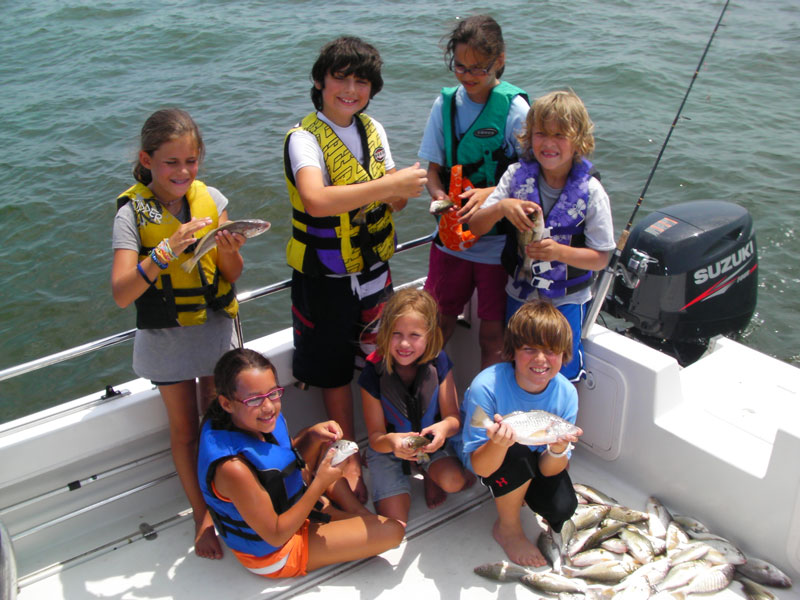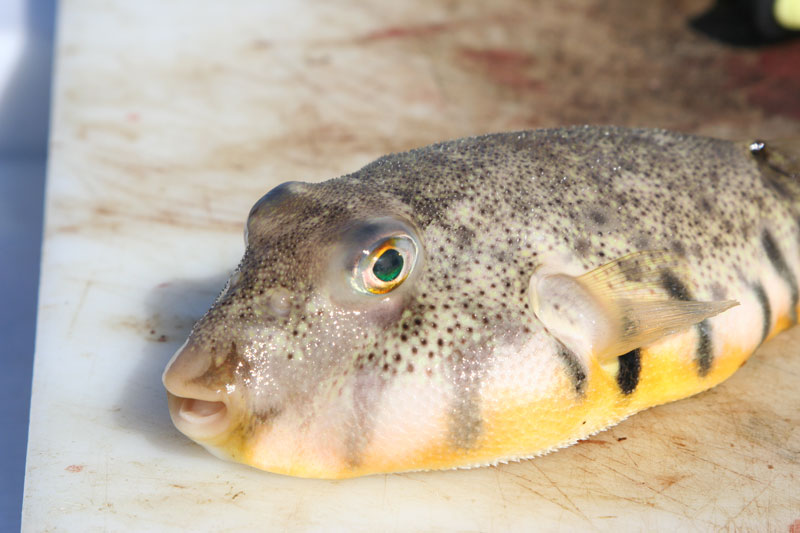While bottom fishing isn’t exactly the most artful form of Chesapeake Bay fishing, it has one advantage over just about any other technique: the best chance for red-hot fast action. Anyone who has kids knows that trolling, jigging, or chumming can lead to boredom, while dropping baits on schools of croaker, white perch, or spot usually leads to instantly bent rods and howls of delight. Free Bonus: bottom fishing is a great way to fill the cooler for dinner. Double Added Bonus: bottom fishing also leads to a great mixed-species catch, and you may luck into numerous species like flounder, puffer fish, stripers, sea trout, kingfish, catfish, black sea bass, and of course the ever-present oyster toad (Woo Hoo!). Triple Mega Bonus: Bottom fishing is really, really easy to master.

Bottom Fishing Basics
Start off by rigging 10- to 20-pound class spinning gear with a simple two-arm top-and-bottom rig, and add enough weight to keep the rig on bottom. Depending on conditions and depth, one to four ounces should get the job done. Use number-six or number-four hooks, and bait up with bits of bloodworm, grass shrimp, clam snouts, peeler crab, or Fishbites. Then locate some structure that holds fish, which can range from the pilings of a pier to a wreck, reef, or oyster bar in open water. Drop the rig to the bottom, and when you feel a nibble set the hook and start reeling.
This is KISS fishing at its finest. There are, however, a few finer points to bottom fishing in the Bay. Here are 10 tips that will make you a more effective angler, the next time you start soaking baits:
- Don’t over-bait your hook. Many bottom fish are relatively small or have small mouths, and if you put a big chunk of bait on a small hook, the fish will grab it and rip it free without ever taking the hook into their jaws. As a general rule of thumb, the bait you use shouldn’t be much bigger than the hook itself.
- Don’t spend too much time jigging the bait or otherwise adding action. Occasionally this helps but more often than not it does more harm than good to lift the bait off bottom for any amount of time.
- If you have a boat with a side-finding fishfinder, when you arrive at a likely location like an oyster bar or a reef site with oyster balls, spend some time idling slowly through the area to ID the best structure. Create waypoints where you spot clusters of reef material or fish. Then, you’ll have a much better idea of where to focus your efforts.
- When fishing from shore, a pier, or a bridge, if you don’t have a particular hotspot you know of within casting range, toss out the bottom rig as far as possible. Then very slowly reel in four or five feet of line to creep the rig along the bottom. Pause for a moment or two, then reel some more line. Using this tactic you can cover more territory, and you’ll sometimes discover a hole, bar, or patch of bottom where the fish are concentrated that’s within casting distance.
- When fishing from a pier or bridge, also try doing the opposite: drop your rig right next to the pilings. Sometimes the fish you’re after are hugging the structure and long casts aren’t only unnecessary, they result in fewer bites.
- If you’re fishing over large reef or bar areas from a boat, unless it’s windy or there’s a very strong current, start by drift-fishing as opposed to sticking to one spot. This will let you cover a lot of territory until you find specific hot zones.
- If you’re fishing over isolated structure like a wreck, or you’ve drift-fished until locating a specific hotspot within a larger area, stick to it like glue. This means anchoring over the structure, or better yet, hovering over it with a “virtual anchoring” system that incorporates GPS. Minn Kota’s Spot-Lock is a prime example, and if you have it on your boat you can press a button and your boat will stay in place while you drop your baits right on top of the fish. When the bite slows up, you can press another button and immediately start probing new territory. (Read Charged Up on the Chesapeake, to learn more about how it can help your fishing endeavors). If your boat isn’t equipped with this functionality, however, you’ll need to work that anchor every time you want to stick to a spot. In either of these cases the bottom line is the same – try to spend as much time as possible in the exact spot you know there are good numbers of fish, until the bite slows and it’s time to move on. You’ll catch a heck of a lot more than if you sit around and wait for the fish to come to you, or drift around and hope to get lucky.
- Break down and buy some bloodworms. Yes, we know they’re ridiculously expensive. But the fact is that virtually every finfish to swim in the Bay loves to eat bloodworms. Generally speaking, they can’t be beat for all-around bottom fishing bait.
- If you’re not getting any bites, leave sooner rather than later. Sure, the tide has an affect on how the fish will feed. But as a rule of thumb species like perch, spot, and croaker are much less tide-oriented than most larger predators and if they’re present, will usually bite. If you spend 15 or 20 minutes in a spot and only get a bite or two, there probably just aren’t many fish there at the moment.
- If you’re fishing over a snaggy bottom, do everything you can to prevent the rig from dragging along. In this case anchoring may be better than drifting, and virtual anchoring is yet again a superior option (because you don’t swing back and forth on an anchor line).
Check out our Live With Lenny episode on Tips for Bottom Fishing in the Chesapeake Bay:

BONUS TIP (because if you can’t tell yet, we just love bonuses): When you catch a small four- or five-inch spot or perch, always rig up a rod and reel that has a live-liner function with an 8/0 to 10/0 circle hook on the end of a 30-pound leader, and toss that little guy right back out there. Then, set the rod in a holder with the live-liner set while you continue bottom fishing. That rig might never get hit, but when a strike does come on that line, it’ll usually result in the largest catch of the day.